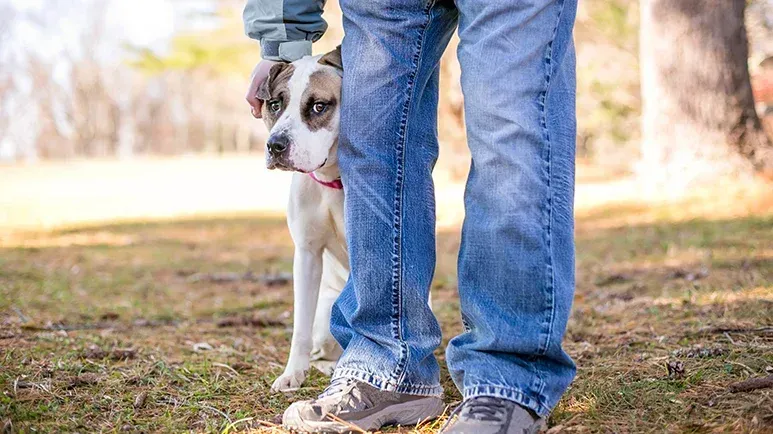STORY AT-A-GLANCE
- Dogs suffer just as we do from anxiety and stress, and left unchecked, the situation can negatively affect their health and quality of life
- There are several classic signs of anxiety in dogs, including yawning, lip licking, trembling, and a tucked tail
- Common triggers of stress and anxiety in dogs include a change in routine, sudden loud noises, and punishment-based training methods
- While some things that may cause anxiety in your dog are outside your control, there are many steps you can take to reduce stressors in your pet's daily life
When we talk about "nervous" dogs, we're really discussing dogs who are anxious. And while you may feel your well-loved and pampered pooch has absolutely no reason to feel stressed, it's important to recognize that dog stressors can be quite different from human stressors.
It's also really important to understand that research clearly shows dogs can and often do experience stress, and according to one study, "There is evidence to suggest that the stress of living with a fear or anxiety disorder can have negative effects on health and lifespan in the domestic dog."1
When dogs feel anxious, their bodies release an excessive amount of norepinephrine, the fight or flight hormone, which has the potential to alter gut bacteria and interfere with gastrointestinal (GI) tract motility.2 This flood of norepinephrine can result in physical symptoms like diarrhea, which only exacerbates a dog's stress — especially if he or she has an accident in the house.
Some dogs primarily experience short-lived stress, but others suffer chronic stress. The more you know about what triggers your pet's anxiety, the behaviors she tends to perform when she's anxious, and the effect of stress on her health, the better able you'll be to identify the signs and take action to minimize or eliminate stressors.
Signs Your Dog Is Anxious
Estimates are that about 30% of dogs show signs of anxiety, identified by either body language or behaviors such as obsessive licking. Since each dog has his own communication style, it's important to learn your pet's signals that he's feeling nervous or stressed.
There are many signs of anxiety in dogs, and they can change over time. Some of them include:3
- Lowered or tucked tail
- Trembling/shaking
- Ears pulled or pinned back
- Increased whining, howling and/or barking
- Yawning or panting
- Diarrhea
- Nose or lip licking
- Reduced or absent appetite
- Cowering, crouched body posture and/or hiding
- Destructive behaviors
If your dog is showing one or more signs that he's anxious, I strongly encourage you to make an appointment with your veterinarian for a wellness checkup. It's important to rule out an underlying medical condition that may be the cause of or a contributor to the anxiety.
8 Common Triggers for Anxiety in Dogs
Some of the causes of stress in dogs are species-specific, while others are triggers that can cause anxiety in humans as well. And just like sensitive people, sensitive dogs generally tend to be more susceptible to stress. Some common triggers include:
- Sudden loud noises (e.g., fireworks, thunderstorms)
- Punishment-based training methods involving yelling, hitting, shock collars, etc.
- Adverse relationships with other pets or humans in the household
- Unwanted attention such as being randomly awakened from a nap, or being forcibly hugged, kissed or held
- Lack of opportunities to express normal species- and breed-specific behaviors such as running, retrieving, hunting, herding, etc.
- Exposure to the strange and unfamiliar (objects, animals, people, etc.)
- Changes in housing, household routine, or household members
- Separation from family members, including other pets
As you go about identifying the triggers for your dog's anxiety, also consider her history. If you adopted her, what do you know about her past? Was she abused or neglected? Is she anxious mainly around men or kids? Other dogs?
Some of the things that cause anxiety in dogs can be unavoidable, such as thunderstorms passing through or a move to a new home. However, there are several things you can control to minimize stress and improve your dog's quality of life. Examples:
- Use only positive reinforcement behavior training/trainers.
- Help everyone in the family understand and respect your dog's need for uninterrupted sleep and human handling he feels comfortable with.
- Increase your dog's daily physical activity level, since the vast majority of dogs, especially large breeds, don't get nearly enough. Daily movement is extremely important in mitigating your dog's stress response.
- Dogs left alone for several hours during the day get lonely and bored. If there's often no one home to keep your dog company, recruit a friend or neighbor or hire a dog walker to take him for a stroll around the block, at a minimum. An alternative is doggy daycare.
- Engage in daily brain games and consider signing up for a nose-work class. Helping dogs focus on positives distractions and do fun activities does wonders for reducing stress.
Tips to Calm an Anxious Dog
- Consider adding a probiotic supplement or fermented veggies to your dog's fresh, nutritionally balanced, species-appropriate whole food diet, as studies show probiotics reduce stress-related GI disturbances in dogs and improve the gut-brain axis.
- Make sure your dog gets plenty of exercise, playtime, mental stimulation, attention and affection. Daily rigorous exercise is one of the most overlooked, free and effective treatments for reducing stress that few pet parents take advantage of.
- Add a flower essence blend like Solutions Separation Anxiety to her drinking water and invest in an Adaptil pheromone collar or diffuser.
- When your dog will be home alone, leave him with an article of clothing or blanket with your scent on it and a treat-release toy, place small treats and his favorite toys around the house for him to discover, and put on some soothing doggy music before you leave.
- Also play calm, soothing music before a possible stressor occurs. This may relax your dog and have the added bonus of drowning out distressing noises.
- If your dog responds well to pressure applied to her body, invest in a wrap like the Thundershirt; also consider Ttouch, a specific massage technique that can help anxious pets.
- Calming nutraceuticals and herbs that can be of benefit include holy basil, l-theanine, rhodiola, ashwagandha, bacopa, GABA, 5-HTP and chamomile.
The essential oil of lavender has been proven to reduce the stress response in dogs. Place a few drops on your pet's collar or bedding before a stressor occurs or diffuse the oil around your house. There are also great oil blends specifically for calming animals. - If you've adopted a dog who may have had a rocky start in life, I highly recommend a program called A Sound Beginning, which is designed to help rescue dogs and their adopters learn to communicate effectively and form an unbreakable bond.
- If your dog's anxiety seems to be getting worse instead of better, consider an individualized approach to managing her stress by allowing her to choose what best soothes her via applied zoopharmacognosy (self-healing techniques offered through a trained professional). If she becomes destructive seek the help of a qualified, fear-free behaviorist who will create a customized program for your pup.




